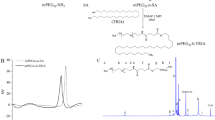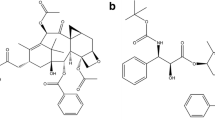Abstract
Paclitaxel (PTX) is one of the most effective anticancer drugs for the treatment of various solid tumors, but its clinical use is limited by its poor solubility, low bioavailability, and severe systemic toxicity. Encapsulation of PTX in polymeric nanoparticles is used to overcome these problems but these micelles still need improvements in stability, pharmacokinetics, therapeutic efficacy, and safety profiles. In this study, we demonstrate a facile fabrication of a stable PTX-binding micelle made from poly (ethylene glycol)-block-dendritic polylysine, whose primary amines were reacted with phenethyl isothiocyanate (PEITC), a hydrophobic anticancer agent under clinical study. The amphiphilic conjugate (PEG-Gx-PEITC; Gx, the generation of the polylysine dendron) formed well-defined micelles whose core was composed of phenyl groups and thiourea groups binding PTX via π-π stacking and hydrogen bonding. Compared with the PTX-loaded poly(ethylene glycol)-block-poly(D,L-lactide) (PEGPDLLA/ PTX) micelles in clinical use, PTX-loaded PEG-Gx-PEITC third-generation (PEG-G3-PEITC/PTX) micelles showed slowed blood clearance, enhanced tumor accumulation, and thus much improved in vivo therapeutic efficacy in both subcutaneous and orthotopic human breast cancer xenografts. Therefore, PEG-G3-PEITC is a promising drug delivery system for PTX in the treatment of breast cancer.
Similar content being viewed by others

References
Berglund, M., Dalence-Guzman, M.F., Skogvall, S., and Sterner, O. (2008). SAR studies of capsazepinoid bronchodilators. Part 2: chlorination and catechol replacement in the A-ring. Bioorgan Med Chem 16, 2513–2528.
Burt, H.M., Zhang, X., Toleikis, P., Embree, L., and Hunter, W.L. (1999). Development of copolymers of poly(D,L-lactide) and methoxypolyethylene glycol as micellar carriers of paclitaxel. Colloids Surface B 16, 161–171.
Carstens, M.G., de Jong, P.H.J.L.F., van Nostrum, C.F., Kemmink, J., Verrijk, R., de Leede, L.G.J., Crommelin, D.J.A., and Hennink, W.E. (2008). The effect of core composition in biodegradable oligomeric micelles as taxane formulations. Eur J Pharm Biopharm 68, 596–606.
Chen, H., Kim, S., He, W., Wang, H., Low, P.S., Park, K., and Cheng, J.X. (2008). Fast release of lipophilic agents from circulating PEG-PDLLA micelles revealed by in vivo forster resonance energy transfer imaging. Langmuir 24, 5213–5217.
Fang, R.H., Aryal, S., Hu, C.M.J., and Zhang, L. (2010). Quick synthesis of lipid-polymer hybrid nanoparticles with low polydispersity using a single-step sonication method. Langmuir 26, 16958–16962.
Guo, Z., Zou, Y., He, H., Rao, J., Ji, S., Cui, X., Ke, H., Deng, Y., Yang, H., Chen, C., et al. (2016). Bifunctional platinated nanoparticles for photoinduced tumor ablation. Adv Mater 28, 10155–10164.
Gupta, P., Wright, S.E., Kim, S.H., and Srivastava, S.K. (2014). Phenethyl isothiocyanate: a comprehensive review of anti-cancer mechanisms. Biochim Biophys Acta 1846, 405–424.
Kim, S.C., Kim, D.W., Shim, Y.H., Bang, J.S., Oh, H.S., Kim, S.W., and Seo, M.H. (2001). In vivo evaluation of polymeric micellar paclitaxel formulation: toxicity and efficacy. J Control Release 72, 191–202.
Liu, K., Cang, S., Ma, Y., and Chiao, J.W. (2013). Synergistic effect of paclitaxel and epigenetic agent phenethyl isothiocyanate on growth inhibition, cell cycle arrest and apoptosis in breast cancer cells. Cancer Cell Int 13, 10.
Mishra, A., Dwivedi, J., Shukla, K., and Malviya, P. (2014). X-Ray diffr-action and Fourier transformation infrared spectroscopy studies of copper (II) thiourea chloro and sulphate complexes. Journal of Physics Conference Series.
Muthoosamy, K., Abubakar, I.B., Bai, R.G., Loh, H.S., and Manickam, S. (2016). Exceedingly higher co-loading of curcumin and paclitaxel onto polymer-functionalized reduced graphene oxide for highly potent synergistic anticancer treatment. Sci Rep 6, 32808.
Saeed, A., Bolte, M., Erben, M.F., and Pérez, H. (2015). Intermolecular interactions in crystalline 1-(adamantane-1-carbonyl)-3-substituted thioureas with Hirshfeld surface analysis. Crystengcomm 17, 7551–7563.
Shao, S., Zhou, Q., Si, J., Tang, J., Liu, X., Wang, M., Gao, J., Wang, K., Xu, R., and Shen, Y. (2017). A non-cytotoxic dendrimer with innate and potent anticancer and anti-metastatic activities. Nat Biomed Eng 1, 7-45–757.
Singla, A.K., Garg, A., and Aggarwal, D. (2002). Paclitaxel and its formulations. Int J Pharm 235, 179–192.
Skog, S., He, Q., Khoshnoud, R., Fornander, T., and Rutqvist, L.E. (2004). Genes related to growth regulation, DNA repair and apoptosis in an oestrogen receptor-negative (MDA-231) versus an oestrogen receptorpositive (MCF-7) breast tumour cell line. Hum Hered 25, 41–47.
Stirland, D.L., Nichols, J.W., Miura, S., and Bae, Y.H. (2013). Mind the gap: a survey of how cancer drug carriers are susceptible to the gap between research and practice. J Control Release 172, 1045–1064.
Sun, Q., Radosz, M., and Shen, Y. (2012). Challenges in design of translational nanocarriers. J Control Release 164, 156–169.
Tang, B., Fang, G., Gao, Y., Liu, Y., Liu, J., Zou, M., and Cheng, G. (2014). Liprosomes loading paclitaxel for brain-targeting delivery by intravenous administration: in vitro characterization and in vivo evaluation. Int J Pharm 475, 416–427.
Tang, Z., He, C., Tian, H., Ding, J., Hsiao, B.S., Chu, B., and Chen, X. (2016). Polymeric nanostructured materials for biomedical applications. Prog Polymer Sci 60, 86–128.
Tyrrell, Z.L., Shen, Y., and Radosz, M. (2010). Fabrication of micellar nanoparticles for drug delivery through the self-assembly of block copolymers. Prog Polymer Sci 35, 1128–1143.
Wang, J., Sun, X., Mao, W., Sun, W., Tang, J., Sui, M., Shen, Y., and Gu, Z. (2013). Tumor redox heterogeneity-responsive prodrug nanocapsules for cancer chemotherapy. Adv Mater 25, 3670–3676.
Wang, Y.J., Wang, C., Gong, C.Y., Wang, Y.J., Guo, G., Luo, F., and Qian, Z.Y. (2012). Polysorbate 80 coated poly (-caprolactone)-poly (ethylene glycol)-poly (-caprolactone) micelles for paclitaxel delivery. Int J Pharm 434, 1–8.
Wei, Y., Li, L., Xi, Y., Qian, S., Gao, Y., and Zhang, J. (2014). Sustained release and enhanced bioavailability of injectable scutellarin-loaded bovine serum albumin nanoparticles. Int J Pharm 476, 142–148.
Wu, X., Zhou, Q., and Xu, K. (2009). Are isothiocyanates potential anticancer drugs? Acta Pharmacol Sin 30, 501–512.
Xi, X., Hu, S., Zhou, Z., Liu, X., Tang, J., and Shen, Y. (2016). Dendrimers with the protocatechuic acid building block for anticancer drug delivery. J Mater Chem B 4, 5236–5245.
Xiao, K., Luo, J., Fowler, W.L., Li, Y., Lee, J.S., Xing, L., Cheng, R.H., Wang, L., and Lam, K.S. (2009). A self-assembling nanoparticle for paclitaxel delivery in ovarian cancer. Biomaterials 30, 6006–6016.
Yano, S., Takehara, K., Kishimoto, H., Tazawa, H., Urata, Y., Kagawa, S., Bouvet, M., Fujiwara, T., and Hoffman, R.M. (2016). In vivo selection of intermediately- and highly-malignant variants of triple-negative breast cancer in orthotopic nude mouse models. Anticancer Res 36, 6-273–6278.
Zhang, P., Huang, Y., Liu, H., Marquez, R.T., Lu, J., Zhao, W., Zhang, X., Gao, X., Li, J., Venkataramanan, R., et al. (2014). A PEG-Fmoc conjugate as a nanocarrier for paclitaxel. Biomaterials 35, 7146–7156.
Zhang, P., Huang, Y., Kwon, Y.T., and Li, S. (2015). PEGylated fmocamino acid conjugates as effective nanocarriers for improved drug delivery. Mol Pharm 12, 1680–1690.
Zhao, B., Zhou, Z., and Shen, Y. (2016). Effects of chirality on gene delivery efficiency of polylysine. Chin J Polym Sci 34, 94–103.
Zhao, L., Zhou, Y., Gao, Y., Ma, S., Zhang, C., Li, J., Wang, D., Li, X., Li, C., Liu, Y., et al. (2015). Bovine serum albumin nanoparticles for delivery of tacrolimus to reduce its kidney uptake and functional nephrotoxicity. Int J Pharm 483, 180–187.
Zhou, Z., Ma, X., Jin, E., Tang, J., Sui, M., Shen, Y., Van Kirk, E.A., Murdoch, W.J., and Radosz, M. (2013). Linear-dendritic drug conjugates forming long-circulating nanorods for cancer-drug delivery. Biomaterials 34, 5722–5735.
Zhou, Z., Ma, X., Murphy, C.J., Jin, E., Sun, Q., Shen, Y., Van Kirk, E.A., and Murdoch, W.J. (2014). Molecularly precise dendrimer-drug conjugates with tunable drug release for cancer therapy. Angew Chem Int Ed 53, 10949–10955.
Zhou, Z., Liu, X., Zhu, D., Wang, Y., Zhang, Z., Zhou, X., Qiu, N., Chen, X., and Shen, Y. (2017). Nonviral cancer gene therapy: delivery cascade and vector nanoproperty integration. Adv Drug Deliver Rev 115, 115–154.
Zhu, A., Miao, K., Deng, Y., Ke, H., He, H., Yang, T., Guo, M., Li, Y., Guo, Z., Wang, Y., et al. (2015). Dually pH/reduction-responsive vesicles for ultrahigh-contrast fluorescence imaging and thermo-chemotherapy-synergized tumor ablation. ACS Nano 9, 7874–7885.
Acknowledgements
This work was supported by the National Natural Science Foundation of China (U1501243, 51603181), the National Basic Research Program (2014CB931900), the National Natural Science Foundation of China (51603181) and the Fundamental Research Funds for the Central Universities (2016QNA4024) for financial support.
Author information
Authors and Affiliations
Corresponding authors
Electronic supplementary material
Rights and permissions
About this article
Cite this article
Xiang, J., Wu, B., Zhou, Z. et al. Synthesis and evaluation of a paclitaxel-binding polymeric micelle for efficient breast cancer therapy. Sci. China Life Sci. 61, 436–447 (2018). https://doi.org/10.1007/s11427-017-9274-9
Received:
Accepted:
Published:
Issue Date:
DOI: https://doi.org/10.1007/s11427-017-9274-9



